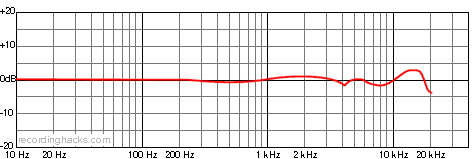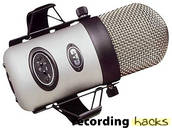 CAD Audio VSM-1
CAD Audio VSM-1
Cardioid Tube Condenser Microphone
The VSM-1, aka VSM, was a fixed-cardioid condenser microphone with a large-diameter capsule and a hybrid tube/solid-state amplifier circuit described at the time as “servo-valve technology.” It produced a sound described by reviewers as translucent and uncolored.
The input stage used a 12AX7 tube, as did the input stage of the company’s dual-tube VX2. (The review mic sent to SoundOnSound contained a Sovtek tube.)
But where the VX2 used a second tube for the output stage, the VSM used a “differential amplifier,” reported by SOS to be a Burr Brown OPA2107 high-speed dual operational amplifier. A similar output circuit can be found in CAD’s Equitek series of microphones.
The mic’s capsule was CAD’s “Optema” design: a large-diaphragm, center-terminated, dual-diaphragm design with 3-micron, gold-sputtered membranes. Optema capsules were built in the US and tensioned and tuned by hand prior to installation. The diaphragms measured 28mm; the outside diameter of the capsule assembly measured 34mm.
The VSM shipped with a shockmount, dual-voltage (117/220V) tube power supply, and a 30' cable in a locking black plastic flight case. The case was designed to hold the mic in its shockmount, facilitating setup and teardown.
SoundOnSound
The VSM1 is a lovely microphone to use because it has that flattering, slightly warm sound quality which is so characteristic of a valve amplifier combined with a large capsule. Performing well on a wide range of sources, it gave a fast, detailed and involving sound with a lovely warmth and presence in most cases. I particularly liked the VSM1 on close-miked voices and more distant stringed instruments, and the presence peak seemed to complement male voices particularly well.
Electronic Musician, 2000
Compared with the … TLM 103, C 414 [EB], and AT4050, the VSM consistently captured a truer-to-life sonic image while still sounding pleasantly distinctive. In contrast, the TLM 103 sounded sibilant; the C 414, lacking in body; and the AT4050, significantly smaller. Certainly, each of these mics has characteristics that might be complementary to particular instruments in various situations; overall, though, the VSM sounded better to my ears.
The CAD Audio VSM-1 is also known as: VSM.
The mic was released in 1999.
Specifications
| Frequency Response - CardioidClick Graph to Compare! |
|---|
 |
| Pickup Patterns | Pads & Filters |
|---|---|
|
Cardioid
(22 mV/Pa; 10 - 20,000 Hz) |
|
| Capsule Dimensions | Impedance | SPL/Noise |
|---|---|---|
| Diaphragm diameter: 28mm Capsule diameter: 34mm Diaphragm gauge: 3 microns |
200 Ohms (Low) | Max SPL: 150 dB Self-noise: 15.0 dB(A) |
| Weight | Length | Max Diameter | Interface(s) |
|---|---|---|---|
| 900g (31.75oz) | 174mm (6.85'') | 73mm (2.87'') |
|
| Power Specifications |
|---|
|
Did we get anything wrong on this page? Please let us know!

